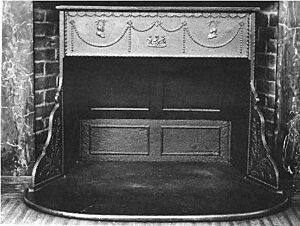Franklin stove facts for kids
The Franklin stove is a special metal fireplace. It was invented by Benjamin Franklin in 1742. This stove was designed to make a room warmer and produce less smoke than a regular open fireplace. People also called it a "circulating stove" or the "Pennsylvania fireplace." It became more popular after David Rittenhouse improved it.
Contents
How the Franklin Stove Works
The Franklin stove had two main new ideas. It used a hollow baffle and an "inverted siphon." These ideas helped the stove heat rooms better.
What is a Baffle?
A baffle is a metal panel that helps control how air or smoke moves. In a fireplace, baffles make the hot air or smoke travel a longer path. This longer path means more heat can transfer from the fire to the room.
Imagine cool air entering a duct near the fire. As it moves through the duct, it gets heated by the hot walls. This warm air then rises and goes back into the room. The longer the path, the more heat the air picks up. The same idea works for smoke. Making smoke travel a longer path before it leaves the chimney helps capture more heat from it.
Other inventors used baffles before Franklin:
- In 1618, Franz Kessler from Germany made a stove where smoke snaked through five chambers. This helped save wood.
- In 1624, Louis Savot, a French doctor, built a fireplace in the Louvre. It had ducts that warmed cool air before sending it back into the room.
- In 1713, Nicolas Gauger, another Frenchman, designed fireplaces with hollow spaces and baffles. Cool air would enter, warm up, and then return to the room.
Franklin's stove had a hollow baffle inside it. This baffle was a thin, cast-iron box. Air entered the bottom of the box and was heated by the fire and smoke. The warm air then rose and left through holes in the baffle's sides. This design did two things: it made the smoke travel further, and it heated the room's air by moving it around.
What is an Inverted Siphon?
An inverted siphon is a clever way to make hot gases move. Imagine a U-shaped pipe. If hot gases go up one side of the U, they can pull smoke down the other side first, then up the chimney. Franklin called this an "aerial siphon" or "siphon reversed."
This idea was used to pull the fire's hot smoke around the Franklin stove's hollow baffle. This helped get as much heat as possible from the smoke before it went up the chimney.
Some earlier examples of this idea include:
- Franz Kessler's 1618 fireplace forced smoke to go down behind a baffle before leaving.
- Prince Rupert's 1678 fireplace had a hanging iron door. Smoke had to go down under the door before rising into the chimney.
- In 1686, André Dalesme showed a "smokeless stove" in Paris. It pulled smoke downwards into the fire, making very little smoke or smell. This showed that fires could be used indoors without filling the house with smoke.
Franklin's stove used this inverted siphon idea. It had a baffle that made smoke flow downwards before reaching the chimney. This needed a special U-shaped duct in the floor behind the stove.
Developing the Stove
Benjamin Franklin learned a lot from other inventors. He read books by John Theophilus Desaguliers, who had translated Nicolas Gauger's ideas into English. Franklin then used these ideas and new scientific concepts about heat to create his own stove.
In 1742, Franklin finished his first design. He got his materials from William Branson, an iron maker in Pennsylvania. Franklin wanted everyone to be able to use his stoves. He didn't want to get a patent for his invention. He believed that since we benefit from others' inventions, we should share our own freely.
Because he didn't patent it, many others could use and improve his design. The first Franklin stoves were made by the Reading furnaces. Two years later, Franklin wrote a pamphlet to explain his stove and help sell it.
Even though his stove was meant for both cooking and heating, it mostly became known for heating rooms. Many people improved on the Franklin stove over time. Today, most American fireplaces are still box-shaped, much like Franklin's original design. One famous exception is the Rumford fireplace, designed by Benjamin Thompson.
Stove Design and Improvements
The Franklin stove was about 30 inches (76 cm) tall and shaped like a box. The front was open, with a decorative panel at the top. The back of the stove sat a few inches from the chimney. Holes at the bottom allowed smoke to escape into the chimney. Iron screws held the panels together. Inside, a thin rectangular piece forced the smoke into the holes. All the parts were made of iron.
Franklin's first stove didn't sell very well. The problem was with the inverted siphon. The smoke had to go through a cold pipe in the floor before reaching the chimney. This made the smoke cool down too much, and the stove didn't draw smoke well. The inverted siphon only worked properly if the fire burned constantly, keeping the pipe hot.
Later, David Rittenhouse designed a better version. His stove fixed many of the problems Franklin's original design had. Rittenhouse's improved stove became very popular. However, because Franklin was so famous, history still remembers it as the Franklin Stove. The smaller Latrobe stove, also called a Baltimore Heater, was patented in 1846 and became popular too.
See also
- Air-tight stove
- Angithi
- Bukhari (heater), traditional Indian wood stove
- Fireplace
- Hearth
- Masonry heater
- Potbelly stove
- Rocket mass heater
- Rumford fireplace
- Space heater
- Wood-burning stove
- Samuel Van Leer


